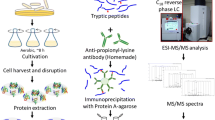Abstract
In this study, we confirmed N-terminal myristoylation of Tetrahymena pyriformis arginine kinase (AK1) by identifying a myristoylation signal sequence at the N-terminus. A sufficient amount of modified enzyme was synthesized using an insect cell-free protein synthesis system that contains all of the elements necessary for post-transcriptional modification by fatty acids. Subsequent peptide mass fingerprinting (PMF) analyses were performed after digestion with trypsin. The PMF data covered 39 % (143 residues) of internal peptides. The target N-myristoylated peptide had a theoretical mass of 832.4477 and was clearly observed with an experimental mass (m/z-H+) of 832.4747. The difference between the two masses was 0.0271, supporting the accuracy of identification and indicating that the synthesized T. pyriformis AK1 is myristoylated. The fixed specimens of T. pyriformis were reacted with an anti-AK1 peptide antibody followed by a secondary antibody with a fluorescent chromophore and were observed using immunofluorescence microscope. In agreement with previous western blotting analyses, microscopic observations suggested that AK1 is localized in the cilia. The present PMF and microscopic analyses indicate that T. pyriformis AK1 may be localized and anchored to ciliary membranes via N-terminal myristoyl groups.


Similar content being viewed by others
Abbreviations
- AK:
-
Arginine kinase
- PMF:
-
Peptide mass fingerprinting
References
Resh MD (1999) Fatty acylation of proteins: new insights into membrane targeting of myristoylated and palmitoylated proteins. Biochim Biophys Acta 1451:1–16
Aicart-Ramos C, Valero RA, Rodriguez-Crespo I (2011) Protein palmitoylation and subcellular trafficking. Biochim Biophys Acta 1808:2981–2994
Ellington WR (2001) Evolution and physiological roles of phosphagen systems. Annu Rev Physiol 63:289–325
Pereira C, Alonso G, Paveto M, Iribarren A, Cabanas M, Torres H, Flawia M (2000) Trypanosoma cruzi arginine kinase characterization and cloning. A novel energetic pathway in protozoan parasites. J Biol Chem 275:1495–1501
Andrews LD, Graham J, Snider MJ, Fraga D (2008) Characterization of a novel bacterial arginine kinase from Desulfotalea psychrophila. Comp Biochem Physiol Part B Biochem Mol Biol 150:312–319
Suzuki T, Soga S, Inoue M, Uda K (2013) Characterization and origin of bacterial arginine kinases. Int J Biol Macromol 57:273–277
Michibata J, Okazaki N, Motomura S, Uda K, Fujiwara S, Suzuki T (2014) Two arginine kinases of Tetrahymena pyriformis: characterization and localization. Comp Biochem Physiol Part B Biochem Mol Biol 171:34–41
Okazaki N, Motomura S, Okazoe N, Yano D, Suzuki T (2015) Cooperativity and evolution of Tetrahymena two-domain arginine kinase. Int J Biol Macromol 79:696–703
Suzuki T, Ito M, Ezure T, Shikata M, Ando E, Utsumi T, Tsunasawa S, Nishimura O (2006) N-Terminal protein modifications in an insect cell-free protein synthesis system and their identification by mass spectrometry. Proteomics 6:4486–4495
Suzuki T, Ito M, Ezure T, Shikata M, Ando E, Utsumi T, Tsunasawa S, Nishimura O (2007) Protein prenylation in an insect cell-free protein synthesis system and identification of products by mass spectrometry. Proteomics 7:1942–1950
Quest AF, Chadwick JK, Wothe DD, McIlhinney RA, Shapiro BM (1992) Myristoylation of flagellar creatine kinase in the sperm phosphocreatine shuttle is linked to its membrane association properties. J Biol Chem 267:15080–15085
Wothe DD, Charbonneau H, Shapiro BM (1990) The phosphocreatine shuttle of sea urchin sperm: flagellar creatine kinase resulted from a gene triplication. Proc Natl Acad Sci USA 87:5203–5207
Chouno K, Yano D, Uda K, Fujita T, Iwasaki I, Suzuki T (2015) Arginine kinases from the marine feather star Tropiometra afra macrodiscus: the first finding of a prenylation signal sequence in metazoan phosphagen kinases. Comp Biochem Physiol Part B Biochem Mol Biol 187:55–64
Noguchi M, Sawada T, Akazawa T (2001) ATP-regenerating system in the cilia of Paramecium caudatum. J Exp Biol 204:1063–1071
Acknowledgments
We thank Prof. Shigeki Fujiwara of Kochi University for technical advice during Immunofluorescence analyses. This work was supported by a Grant-in-Aid for Scientific Research from the Ministry of Education, Culture, Sports, Science and Technology, Japan, to TS (24570087 and 15K07151).
Author information
Authors and Affiliations
Corresponding author
Rights and permissions
About this article
Cite this article
Motomura, S., Suzuki, T. Evidence for N-Terminal Myristoylation of Tetrahymena Arginine Kinase Using Peptide Mass Fingerprinting Analysis. Protein J 35, 212–217 (2016). https://doi.org/10.1007/s10930-016-9663-0
Published:
Issue Date:
DOI: https://doi.org/10.1007/s10930-016-9663-0




